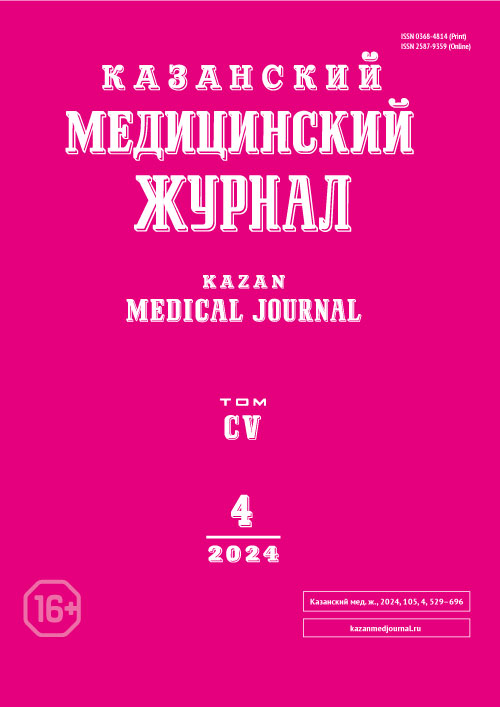Система протеиназы/ингибиторы в патогенезе экспериментального туберкулёза почки
- Авторы: Эсмедляева Д.С.1, Алексеева Н.П.2, Блюм Н.М.3, Дьякова М.Е.1, Виноградова Т.И.1
-
Учреждения:
- Санкт-Петербургский научно-исследовательский институт фтизиопульмонологии
- Санкт-Петербургский государственный университет
- Военно-медицинская академия имени С.М. Кирова
- Выпуск: Том 105, № 4 (2024)
- Страницы: 578-587
- Раздел: Экспериментальная медицина
- Статья получена: 28.11.2023
- Статья одобрена: 27.04.2024
- Статья опубликована: 25.07.2024
- URL: https://kazanmedjournal.ru/kazanmedj/article/view/623992
- DOI: https://doi.org/10.17816/KMJ623992
- ID: 623992
Цитировать
Аннотация
Актуальность. Повреждения паренхимы почек различного генеза связаны с накоплением белков внеклеточного матрикса, в регуляции которых участвует система «матриксные металлопротеиназы/ингибиторы».
Цель. Оценить патогенетическую роль системы протеиназы/ингибиторы крови при экспериментальном туберкулёзе почки.
Материал и методы. При моделировании процесса применяли клинический штамм 5582 генотипа Beijing с множественной лекарственной устойчивостью микобактерий. Исследование было проведено на 20 кроликах, разделённых на три группы: первая (n=6) включала заражённых нелеченых животных; во второй (n=7) и третьей (n=7) проводили противотуберкулёзную терапию перорально в течение 18,5 нед, в третьей лечение проводили в комбинации с однократным введением аутологичных мезенхимных стволовых клеток в ушную вену. В крови определяли уровни матриксных металлопротеиназ-1 и -9, тканевого ингибитора металлопротеиназ-1, цистатина С и нейтрофильной эластазы. Морфологические изменения паренхимы почек по окончании эксперимента оценивали по 26 показателям, включающим тубулоинтерстициальные и сосудистые изменения. Рассчитывали медиану и межквартильные интервалы, применяли критерий Краскела–Уоллиса, ковариационный анализ и метод проективной классификации.
Результаты. Прогрессирование туберкулёза почки сопровождалось значимым повышением уровня нейтрофильной эластазы в 1,9 раза, матриксной металлопротеиназы-9 в 2,2 раза и цистатина С в 1,5 раза по сравнению с исходным уровнем. Лечение, проведённое во второй и третьей группах, способствовало нормализации этих показателей. Концентрации матриксной металлопротеиназы-1 и тканевого ингибитора металлопротеиназ-1 во всех трёх группах относительно исходного уровня не менялись. Ковариационный анализ показал, что в патогенезе туберкулёза почки изменения матриксной металлопротеиназы-1 (р=0,003), матриксной металлопротеиназы-9 (р=0,002), тканевого ингибитора металлопротеиназ-1 (р=0,01) и цистатина С (р=0,0001) прежде всего связаны с сосудистыми изменениями, установленными во всех группах исследования. Выявить различия между тремя группами с точностью 90% позволила линейная комбинация, содержащая три морфологические характеристики.
Вывод. Туберкулёз почек, вызванный штаммом возбудителя с множественной лекарственной устойчивостью, характеризуется дисбалансом в системе протеиназы/ингибиторы, нарушением функций почек, степень которых связана с морфологическими характеристиками сосудистых и тубулоинтерстициальных изменений.
Ключевые слова
Полный текст
Об авторах
Диляра Салиевна Эсмедляева
Санкт-Петербургский научно-исследовательский институт фтизиопульмонологии
Автор, ответственный за переписку.
Email: diljara-e@yandex.ru
ORCID iD: 0000-0002-9841-0061
SPIN-код: 9402-4487
Scopus Author ID: 23110578300
канд. биол. наук, ст. науч. сотрудник, научно-исследовательская лаборатория микробиологии, биохимии и иммуногенетики
Россия, г. Санкт-ПетербургНина Петровна Алексеева
Санкт-Петербургский государственный университет
Email: ninaalexeyeva@mail.ru
ORCID iD: 0000-0001-8837-6739
SPIN-код: 2478-2746
канд. физ.-мат. наук, доц., каф. статистического моделирования
Россия, г. Санкт-ПетербургНаталья Михайловна Блюм
Военно-медицинская академия имени С.М. Кирова
Email: blumn@mail.ru
ORCID iD: 0000-0003-1445-6714
SPIN-код: 4492-6190
Senior Teacher, Depart. of Pathological Anatomy
Россия, г. Санкт-ПетербургМарина Евгеньевна Дьякова
Санкт-Петербургский научно-исследовательский институт фтизиопульмонологии
Email: marinadyakova@yandex.ru
ORCID iD: 0000-0002-7810-880X
SPIN-код: 7858-4573
д-р биол. наук, ст. науч. сотрудник, научно-исследовательская лаборатория микробиологии, биохимии и иммуногенетики
Россия, г. Санкт-ПетербургТатьяна Ивановна Виноградова
Санкт-Петербургский научно-исследовательский институт фтизиопульмонологии
Email: vinogradova@spbniif.ru
ORCID iD: 0000-0002-5234-349X
SPIN-код: 6354-5070
д-р мед. наук, проф., руководитель, научно-исследовательская лаборатория экспериментальной медицины
Россия, г. Санкт-ПетербургСписок литературы
- Кульчавеня Е.В., Жукова И.И., Холтобин Д.П., и др. Демографические и клинические особенности современного туберкулёза мочеполовой системы // Медицинский альянс. 2013. № 4. С. 71–77. EDN: SNIDWZ
- Kim E.J., Lee W., Jeong W.Y., et al. Chronic kidney disease with genitourinary tuberculosis: Old disease but ongoing complication // BMC Nephrol. 2018. Vol. 19, N. 1. Р. 1–8. doi: 12882-018-0994-2
- Саганова Е.С., Зубина И.М., Богданова Е.О. и др. Диагностическое значение экскреции биомаркёров в оценке морфологических повреждений при первичных гломерулопатиях // Терапевтический архив. 2021. Т. 93, № 6. С. 699–705. doi: 10.26442/00403660.2021.06.200850
- Wozniak J., Floege J., Ostendorf T., Ludwig A. Key metalloproteinase-mediated pathways in the kidney // Nat Rev Nephrol. 2021. Vol. 17, N. 8. Р. 513–527. doi: 10.1038/s41581-021-00415-5
- Chang M. Matrix metalloproteinase profiling and their roles in disease // RSC Adv. 2023. Vol. 13, N. 9. Р. 6304–6316. doi: 10.1039/d2ra07005g
- Zi M., Xu Y. Involvement of cystatin C in immunity and apoptosis // Immunol Lett. 2018. Vol. 196. P. 80–90. doi: 10.1016/j.imlet.2018.01.006
- Ferguson T.W., Komenda P., Tangri N. Cystatin C as a biomarker for estimating glomerular filtration rate // Curr Opin Nephrol Hypertens. 2015. Vol. 24, N. 3. Р. 295–300. doi: 10.1097/MNH.0000000000000115
- Ремезова А.Н., Горелова А.А., Муравьев А.Н., и др. Применение мезенхимных стволовых клеток при заболеваниях почек и мочевыводящих путей: обзор литературы и собственный опыт // Медицинский альянс. 2021. Т. 9, № 2. С. 34–43. doi: 10.36422/23076348-2021-9-2-34-43
- Muraviov A.N., Vinogradova T.I., Remezova A.N. et al. The use of mesenchymal stem cells in the complex treatment of kidney tuberculosis (experimental study) // Biomedicines. 2022. Vol. 10, N. 12. Р. 3062. doi: 10.3390/biomedicines10123062
- Муравьев А.Н., Виноградова Т.И., Догонадзе М.З. и др. Способ моделирования туберкулёза почки. Патент на изобретение РФ №2776130 C1. Номер заявки: 2021120918. EDN: HFLUAT
- Visser L., Blout E. The use of P-Nitrophenil-N-Tertbutyloxylcarbonyl L-Alaninate as substate for elastase // Biochim Biophys Acta BBA-Enzymol. 1972. Vol. 268. P. 257–260. doi: 10.1016/0005-2744(72)90223-9
- Алексеева Н.П., Горлова И.А., Бондаренко Б.Б. Возможности прогнозирования возникновения артериальной гипертензии на основе метода проективной классификации // Артериальная гипертензия. 2017. Т. 23, № 5. С. 472–480. doi: 10.18705/1607-419X-2017-23-5-472-480
- Zakiyanov O., Kalousová M., Zima T., Tesař V. Matrix metalloproteinases in renal diseases: A critical appraisal // Kidney Blood Press Res. 2019. Vol. 44, N. 3. Р. 298–330. doi: org/10.1159/000499876
- Wu X.J., Dong Z.Q., Lu Q.H. The role of cystatin C in vascular remodeling of balloon-injured abdominal aorta of rabbits // Mol Biol Rep. 2014. Vol. 41, N. 9. P. 6225–6231. doi: 10.1007/s11033-014-3502-1
- Левицкая Е.С. Механизмы формирования фиброза почек с учётом микрососудистого поражения // Медицинский вестник Юга России. 2017. № 1. С. 21–27. doi: 10.21886/2219-8075-2017-1-21-27
Дополнительные файлы






